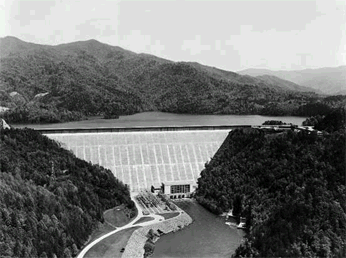|
dam type: concrete
gravity
purpose: flood control, hydroelectric power, navigation, recreation
height: 480 ft (146 m)
width at foundation: 375 ft (114 m)
length of crest: 2365 ft (721 m)
storage capacity: 1,443,000 acre-ft. |

|
owned by: Tennessee Valley Authority
volume of concrete in the dam: 2,818,000 yd3 (2,152,222
m3)
downstream hazard (NID): high
emergency action plan (NID): yes
At the time of planning and construction, Fontana was one of nine dams to be
built to manage the Little Tennessee River. There was no opposition.
They also considered an embankment dam, an arch dam, and a buttress dam for
the project. But the gravity dam design proved the most efficient and
economical and many dams of this type had been built before.
|
construction start date: 1942
construction end date: 1944 (during World War II)
number of workers: 5000.
Welch Cove was built for the workers, which is now Fontana Village.
cost (in 1944): $70,420,688.48
Vertical contraction joints connect large sections of the dam to allow for
expansion and contraction. The downstream face of the dam faces south and
absorbs a large amount of heat from the sun, which causes expansion. |


